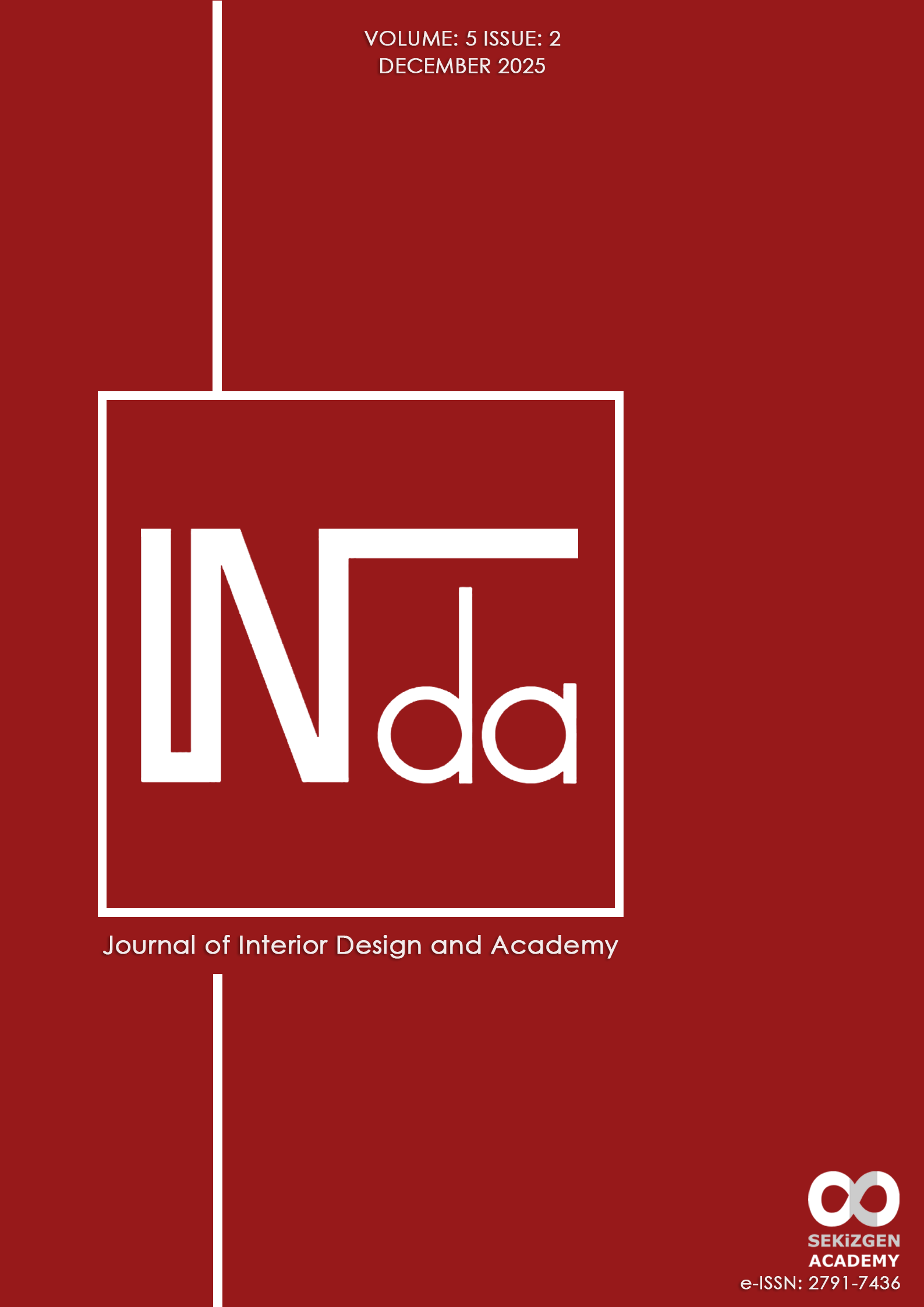Evaluating Biomaterials In Furniture Design Through Sustainability
DOI:
https://doi.org/10.53463/inda.20250391Keywords:
Sustainability, interior design, furniture design, biomaterials, biocompositesAbstract
The present study examines the use of biomaterials in furniture design, focusing on innovative material applications within the framework of sustainability and circular economy principles. The subject of the research encompasses the integration of biomaterials such as mycelium, sawdust-based biocomposites, and bioplastics into design practices and evaluates their potential in terms of industrial scalability, reuse, and recyclability. The aim of the study is to reveal how biomaterials are utilized in furniture design, to analyze their environmental impacts and their relation to the Sustainable Development Goals, and to generate guiding insights for future design processes. The significance of the research lies in the fact that, considering the high raw material consumption and environmental impacts of the furniture industry, biomaterials present ecologically responsible, innovative, and applicable alternatives. The findings demonstrate that biomaterials hold the potential to reduce environmental impacts in furniture design while fostering innovative design languages and production methods.
Downloads
References
Abd-Elazeem, A. (2023). The influence of biology in interior design and furniture to design a biologically sustainable space. Journal of Design Sciences and Applied Arts, 4(2), 477-493.
Alemu, D., Tafesse, M. ve Mondal, A. K. (2022). Mycelium‐based composite: the future sustainable biomaterial. International journal of biomaterials, 2022, 173–182.
Alici, N. ve Dalkılıç, B. (2022). İç mekân donatı elemanlarında biyo-esaslı malzeme kullanımı. GRID Mimarlık, Planlama ve Tasarım Dergisi, 5(2), 325-346. https://doi.org/10.37246/grid.941882
Andrews, K. (2013). Impasto by Nikolaj Steenfatt. Erişim Adresi: https://www.dezeen.com/2013/09/11/impasto-by-nikolaj-steenfatt/ (01.06.2025).
Archiproducts. (t.y.). Kuskoa Bi, the first bioplastic chair. Erişim Adresi: https://www.archiproducts.com/en/news/50-anni-di-maxalto-50-pezzi-della-dormeuse-lilum-firmata-patrick-van-riemsdijk_106716?s=43730 (06.06.2025).
Ay Türkmen, M. ve Kılıç, F. (2020). Sürdürülebilir kalkınma anlayışına yönelik döngüsel ekonomi modeli. Üçüncü Sektör Sosyal Ekonomi, 55(4), 2538-2556.
Aydın, S. ve Tufan, F. (2018). Sürdürülebilirlik ve yeşil kavramları bağlamında y kuşağının satın alma davranışları. Selçuk İletişim, 11(2), 397-420. https://doi.org/10.18094/josc.377009
Barrett, A. (2018). Bioplastics Made from Hair. Erişim Adresi: bioplasticsnews.com/2018/07/18/bioplastics-from-hair-furniture/ (04.06.2025).
Bhattacharya, C. ve Das, M. (2023). Microbial biomaterials and their industrial applications. A. Sarkar, I. A. Ahmed (Ed.), Microbial products for future industrialization (s. 297-314) içinde. Singapore: Springer Nature Singapore.
Caferoğlu, M. (2024). Yenilikçi ve sürdürülebilir yaklaşımla biyoplastik malzemelerin ambalaj tasarımında kullanımı. Journal of Social, Humanities and Administrative Sciences (JOSHAS), 7(46), 2305-2319.
Carley J. (2024), Form Follows Fiber: A Case Study for a Low-Carbon Bioplastic Chair. Industrial Designers Society of America, 1-10.
Chen, L., Zhang, Y., Chen, Z., Dong, Y., Jiang, Y., Hua, J., ... ve Yap, P. S. (2024). Biomaterials technology and policies in the building sector: a review. Environmental Chemistry Letters, 22(2), 715-750.
Çağar, P. K. ve Vural, T. Beyaz eşya sektöründe biyoplastik kullanımı. Uluslararası Sürdürülebilir Mühendislik ve Teknoloji Dergisi, 7(2), 197-215.
Devrim, B. (2023). Mimarlıkta Biyomalzeme Kullanımının Sürdürülebilirlik Üzerine Değerlendirilmesi. (Yüksek Lisans Tezi). Bursa Uludağ Üniversitesi, Bursa. Erişim Adresi: http://hdl.handle.net/11452/33654
El-Naddar, A. ve Shawqi, R. A. (2024). Eco-friendly materials and their role in achieving sustainability in product designs. Advanced Sciences and Technology Journal, 1(1), 1-16.
Ghazvinian, A., Farrokhsiar, P., Vieira, F., Pecchia, J. ve Gursoy, B. (2019). Mycelium-based bio-composites for architecture: Assessing the effects of cultivation factors on compressive strength. Mater. Res. Innov, 2, 505–514.
Grozdanic, L. (2012). Colorful Well Proven Chair is Made from Recycled Wood Waste and Bio-Resin. Erişim Adresi: https://inhabitat.com/the-well-proven-chair-transforms-wood-waste-and-bio-resin-into-unique-furniture/ (01.08.2025).
Güneş, S. ve Demirarslan, D. (2020). Sürdürülebilirlik ve mobilya tasarımında çevreci yaklaşımlar. Uluslararası İnsan ve Sanat Araştırmaları Dergisi, 5(6), 81-99.
Isaac, G. (2020). Plastic chairs: Addressing the environmental emergency. Fusion Journal, (18), 18-29.
Kamel, N. H., Shehata, N. ve AlAkaby, E. (2022). Integrating Bioarchitectural Approaches in the Design of Universities' Halls of Residence to Guarantee Students' Well-being, Journal of Arts & Humanities, (10), 219-237.
Mansilla, C. (2017). Aesthetics, new materials, and efficient functionality: the environmentalist agency of Marjan Van Aubel's objects. Diseña, (11), 220-240.
Maxmen, A. (2013) The fun in fungus. New Scientist, 217 (2901), 51.
Menteşe, S. (2017). Çevresel sürdürülebilirlik açısından toprak, su ve hava kirliliği: Teorik Bir İnceleme. Journal of International Social Research, 10(53), 381-389.
Merriam-Webster. (t.y.). Merriam-Webster Dictionary. Erişim Adresi: www.merriam-webster.com/dictionary/ (13.06.2025).
Monteiro, M. I. F. (2016). Desperdícios de madeira aplicados em soluções de design o serrim (Yüksek lisans tezi). Universidade do Porto. Erişim Adresi: https://core.ac.uk/download/pdf/143396447.pdf
Nguyen, M. T., Solueva, D., Spyridonos, E. ve Dahy, H. (2022). Mycomerge: fabrication of mycelium-based natural fiber reinforced composites on a rattan framework. Biomimetics, 7(2), 42-54.
Özsoy, T. (2018). Döngüsel ekonomi: Almanya’daki durumun bir özeti. Global Journal of Economics and Business Studies, 7(14), 129-143.
Öztürk, T. ve Eroğlu, N. S. (2025). Tekstil ve moda tasarımında kullanılan biyomateryallere örnek bir uygulama. Tekstil ve Mühendis, 32(138), 177-191.
Peters, S. ve Drewes, D. (2019). Materials in progress: innovations for designers and architects. Basel: Birkhäuser
Sak, R., Sak, İ. T. Ş., Şendil, Ç. Ö. ve Nas, E. (2021). Bir araştırma yöntemi olarak doküman analizi. Kocaeli Üniversitesi Eğitim Dergisi, 4(1), 227-256.
Sandak, A., Sandak, J., Brzezicki, M., ve Kutnar, A. (2019). Bio-based building skin. Berlin: Springer Nature.
Shehata, S. (2021). Biotechnology and its applications in ınterior design and furniture. Journal of Design Sciences and Applied Arts, 2(1), 169-179.
Söğüt, M. A. ve Kandemir, A. (2023). Biyomimikri Yaklaşımının Mobilya Tasarımında Sürdürülebilirlikle İlişkisinin İrdelenmesi. Uluslararası İnsan ve Sanat Araştırmaları Dergisi, 8(4), 332-349.
Tufan, M. Z. ve Özel, C. (2018). Sürdürülebilirlik kavramı ve yapı malzemeleri için sürdürülebilirlik kriterleri. Uluslararası sürdürülebilir mühendislik ve teknoloji dergisi, 2(1), 6-13.
Tucknott, T. (2009). Yoav Avinoam's 'Shavings' Stool Makes Use of Waste and Dust. Erişim Adresi: https://www.trendhunter.com/trends/yoav-avinoam-shavings-stool (03.08.2025).
Walker, S. (2010). Temporal Objects—Design, Change and Sustainability. Sustainability, 2(3), 812-832.
Yararel, B. ve Sever, İ. A. (2019). Ekolojik mobilya tasarım süreci üzerine bir inceleme. Online Journal of Art and Design, 7(5), 38-45.
Yılmaz, K. (2023). Biyomimetrik yapı malzemeleri ile post pandemik döneme uygun iç mekanlar tasarlanması. Mimarlık ve Yaşam, 8(2), 299-326. https://doi.org/10.26835/my.1132854
Downloads
Published
How to Cite
Issue
Section
License
Copyright (c) 2025 Journal of Interior Design and Academy

This work is licensed under a Creative Commons Attribution-NonCommercial-ShareAlike 4.0 International License.




















